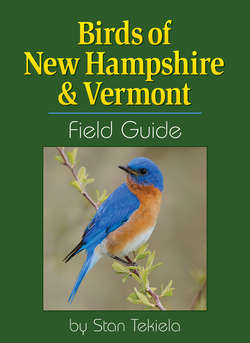Читать книгу Birds of New Hampshire & Vermont Field Guide - Stan Tekiela - Страница 25
На сайте Литреса книга снята с продажи.
ОглавлениеCommon Grackle
Quiscalus quiscula
YEAR-ROUND
SUMMER
| Size: | 11-13" (28-33 cm) |
| Male: | Large black bird with an iridescent blue black head, a purple brown body, long black tail, long thin bill and bright golden eyes. |
| Female: | similar to male, only duller and smaller |
| Juvenile: | similar to female |
| Nest: | cup; female builds; 2 broods per year |
| Eggs: | 4-5; greenish white with brown markings |
| Incubation: | 13-14 days; female incubates |
| Fledging: | 16-20 days; female and male feed young |
| Migration: | complete to partial migrator in New Hamp-shire and Vermont; moves around in search of food |
| Food: | fruit, seeds, insects; comes to seed feeders |
| Compare: | European Starling is much smaller with a speckled appearance, and has a yellow bill during breeding season. Male Red-winged Blackbird has red and yellow wing markings (epaulets). |
Stan’s Notes: Usually nests in small colonies of up to 75 pairs but travels with other blackbird species in large flocks. Known to feed in farmers’ fields. The common name is derived from the Latin word graculus, meaning “to cough,” for its loud raspy call. Male holds its tail in a vertical keel-like position during flight. The flight pattern is usually level, as opposed to an undulating up-and-down movement. Unlike most birds, it has larger muscles for opening the mouth (rather than for closing it) and prying crevices apart to locate hidden insects.
